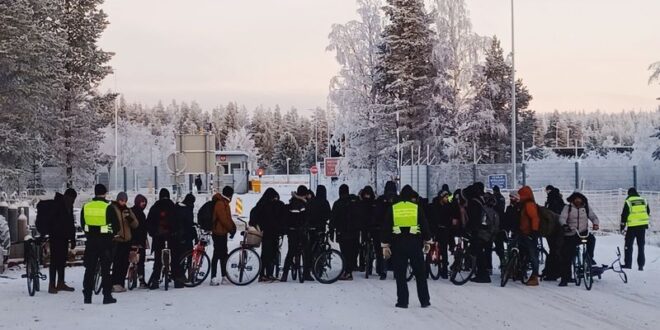HOILOLA, Finland (Reuters) – Only the whine of mosquitoes mars the tranquility of this idyllic spot amid the rolling forests and blue lakes of eastern Finland, on the European Union’s longest border with Russia.
But Finnish authorities fear the peace and quiet of places like Hoilola could soon be shattered by the arrival of large numbers of asylum seekers – part of what Helsinki sees as a “hybrid war” being waged by Russia against the West.
Finland is deploying more border guard patrols, drones and electronic detectors and is building fences along sections of the border. In Helsinki, parliament is expected to approve before its summer recess tough new legislation that critics say will violate the country’s human rights commitments.
Late last year Finland shut all crossing points for travellers along its 1,340 km (833 mile) border with Russia indefinitely after some 1,300 migrants from nations such as Syria and Somalia arrived via that route.
Since then, only a few dozen asylum seekers have crossed the heavily forested border into Finland, but Helsinki believes the Kremlin stands ready to funnel more migrants across at any time – something Moscow has strongly denied.
Under the planned new legislation, Finnish border guards will be able to call on thousands of reservists to help patrol the frontier, to detect migrants’ phone signals, to send the migrants to detention centres and – most controversially – to push them back into Russia without accepting their asylum applications.
“Finland cannot just allow the opening of such a new route (for migrants) into Europe,” Finnish Interior Minister Mari Rantanen, from the nationalist Finns Party, told Reuters.
“But overall this is not about a migrant route: this is about a situation in which the authorities of another country are helping or even pressing and pushing migrants to Finland’s border,” said Rantanen.
Relations with Moscow, once relatively cordial, have deteriorated sharply since Finland’s decision to join NATO following Russia’s invasion of Ukraine on Feb. 24, 2022.
TWO FRIENDS
The tale of Syrian friends Mohammed, 25, and Mahmoud, 27, is illustrative of the challenge now facing Finnish authorities.
They entered Finland via the Salla crossing last November after riding through the snow in temperatures of -20 Celsius (-4 Fahrenheit) on bicycles they said they had bought for $350 each from Russian middlemen at the last Russian checkpoint. Walking between the Russian and Finnish border stations is forbidden.
Mohammed, who fled first to Egypt to avoid the Syrian military draft and then paid $2,500 for a student visa to Russia, insisted he had entered Finland “completely legally”.
“I entered the Russian checkpoint legally and they gave me an exit stamp. In Finland, I showed them the exit stamp and they immediately let me in,” he told Reuters, adding that he had then asked for asylum on the Finnish side.
Mohammed and Mahmoud said they had first paid $5,000 each to a Syrian smuggler to reach Germany via Belarus but had got beaten up and then pushed back by Polish and Lithuanian border guards. Echoing Finland’s accusation against Russia, Poland and the Baltic states have accused Belarus, a Moscow ally, of similarly funnelling migrants to their shared border since 2021.
“Suddenly there was news that the Finnish border (with Russia) had opened. It was also on Telegram and there were smugglers already publicising their services to send people to Finland,” Mahmoud recalled.
The Syrian friends are still awaiting a decision from Finnish authorities on their asylum applications.
Despite the increased tensions with Moscow, Finnish border guards still hold regular meetings with their Russian counterparts, deputy commander Samuli Murtonen said, as he made sure his German shepherd patrol dog did not cross the 10-metre (32 ft) forest clearing to the Russian side of the frontier.
“The basic issue is that, in their view, anyone who stays in Russia legally can leave the country,” he told Reuters, adding that previously Russian border guards had not let anyone cross without a valid visa for the European Union.
‘PROVOCATION’
Russia, for its part, has accused Finland of manufacturing the border situation by inviting the migrants itself.
“We believe that the deliberate provocation of a ‘migration crisis’ on the Russian-Finnish state border is necessary for the Finnish authorities to implement the plans of NATO and, above all, the United States to deploy military field infrastructure and deploy foreign troops on their territory, including in areas bordering Russia,” the head of the Russian Federal Security Service’s (FSB) border service, Vladimir Kulishov, told the state-run RIA news agency on May 28.
Rantanen dismissed that assertion as absurd. She provided no evidence for her February claim, which she said remained valid, that thousands of migrants were still in the border area waiting to cross into Finland, citing classified intelligence.
Her ministry has acknowledged that plans for temporary legislation to push migrants back into Russia would breach Finland’s international human rights commitments.
Amnesty International said on Monday the plans undermined access to asylum and risked “serving as a green light for violence and pushbacks at the border”.
Mahmoud, meanwhile, said it was clear to him that Russian border authorities had controlled their exit to Finland, allowing only a limited number of migrants through at a time.
“If Russia wants to drown Finland with refugees, it can. It can send tens of thousands of refugees,” he said.
(Reporting by Anne Kauranen in Helsinki and Riham Alkousaa in Berlin, additional reporting by Andrius Sytas; Editing by Gareth Jones)
 BeritaKini.biz Berita Viral Terkini di Malaysia
BeritaKini.biz Berita Viral Terkini di Malaysia





